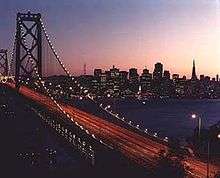Bridge trilogy
The Bridge trilogy is a series of novels by William Gibson, his second after the successful Sprawl trilogy. The trilogy comprises the novels Virtual Light (1993), Idoru, (1996) and All Tomorrow's Parties (1999). A short story, "Skinner's Room", was originally composed for Visionary San Francisco, a 1990 museum exhibition exploring the future of San Francisco.
Setting

The first book of the Bridge trilogy is set in an imaginary 2006, with the subsequent books set a few years later.[1] The books deal with the race to control the beginnings of cyberspace technology and are set on the United States' West coast in a post-earthquake California (divided into the separate states of NoCal and SoCal), as well as a post-earthquake Tokyo, Japan, that had been rebuilt using nanotechnology.
The trilogy derives its name from the San Francisco–Oakland Bay Bridge, which was abandoned in an earthquake and has become a massive shantytown and a site of improvised shelter. The bridge becomes a pivotal location in Virtual Light and All Tomorrow's Parties. The 'bridge' may also be interpreted as a metaphor for the nascent technologies bridging contemporaneous life and the highly advanced future depicted in the Sprawl trilogy, where cyberspace and nanotechnology are fully developed and commonplace.
Characters in each novel interact in a cyberspace construct of Kowloon Walled City, which is initially described as an inverted kill file. The walled city shares a number of features with the bridge itself, including an emphasis on self-governance and efficiency in user-construction.
Characters
The novels of the Bridge trilogy loosely share a common cast of characters. Former police officer Berry Rydell and bicycle courier Chevette Washington occupy central roles in the first and third novels. Researcher Colin Laney, who has a mysterious ability to identify patterns in vast tracts of information, appears in Idoru and All Tomorrow's Parties. Other recurring characters include Rei Toei, an AI pop star, and Shinya Yamazaki, an existential sociologist.
Major themes
The Bridge trilogy incorporates elements of William Gibson's recurring exploration of the intersection of technology, traumatic change, and cyborg self-perceptions. The original San Francisco–Oakland Bay Bridge exists within the old technological system of steel-based construction techniques. After the traumatic shock of the earthquake, which destabilizes both the literal bridge and the technological system of which it is a part, a new technological system emerges. Two representative examples of the new technology are the nanotechnology-based tunnel that replaces the bridge and the ad hoc community built on the damaged bridge. The concept of the nodal point permeates the Bridge trilogy.[2]
All three of the Bridge books had thriller armature and science fiction clothes and really a kind of nineties attitude.
William Gibson in interview with the California Literary Review, October 2007[3]
Critical reception and influence
Canadian Poet Douglas Barbour said of the trilogy that it "has all the stylistic verve of his earlier work, but it asks some tougher questions, explores character more deeply, and savagely interrogates our star-obsessed society."[4] Virtual Light, the first novel in the series, was nominated for both the Hugo and Locus Awards in 1994.[5]
References
- ↑ Book Expo America Luncheon Talk, William Gibson's blog, May 31, 2010.
- ↑ Burt, Jillian (16 July 2007). "William Gibson Maps Mediated World in New Novel". PopMatters.
- ↑ Dueben, Alex (October 2, 2007). "William Gibson: The Father of Cyberpunk". California Literary Review. Retrieved January 2, 2010.
- ↑ Seed, David (2005). A Companion to Science Fiction. Blackwell Publishing Professional. p. 314. ISBN 1-4051-1218-2.
- ↑ "1994 Award Winners & Nominees". Worlds Without End. Retrieved 2009-07-17.